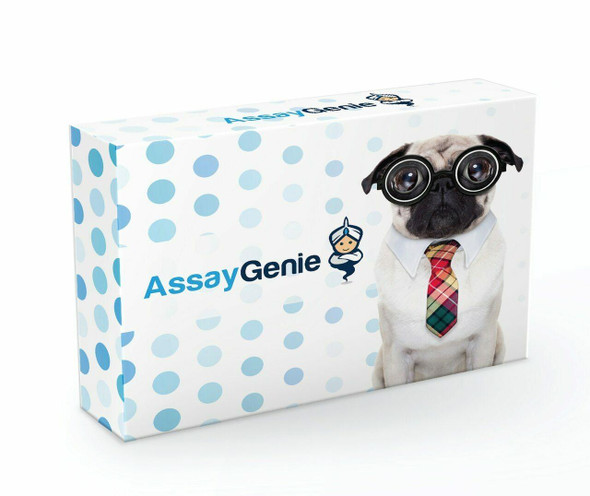Description
| Product Name: | Avian Influenza Virus H9 Antibodies ELISA Kit |
| Target: | AIV-H9-Ab |
| SKU: | AEES00736 |
| Size: | 96T |
| Reactivity: | Poultry |
| Sample Type: | Serum, Plasma, Yolk |
| Detection Method: | Competitive ELISA |
| Assay Time: | 75 min |
| Result Type: | Qualitative; Sensitivity>98%, Specificity>98% |
| Detection Wavelength: | 450/630nm |
| Storage: | The majority of kits have a shelf-life of 12 months from the production date at 2-8℃. |
| Component | Specification |
| ELISA Microtiter plate | 96 Wells |
| HRP Conjugate | 11 mL |
| 25×Concentrated Wash Buffer | 40 mL |
| Substrate Reagent A | 6 mL |
| Substrate Reagent B | 6 mL |
| Antibody Working Solution | 6 mL |
| Stop Solution | 6 mL |
| Positive Control | 1 mL |
| Negative Control | 1 mL |
| Plate Sealer | 3 pieces |
| Plate Sealer | 1 piece |
| Sealed Bag | 1 copy |
Other materials and equipment required:
- Microplate Reader with 450nm wavelength filter or dual-wavelength (450/630nm)
- High-precision transferpettor, EP tubes and disposable pipette tips
- 37℃ incubator or water bath
- Deionized or distilled water
- Absorbent paper
- Physiological saline solution (0.9%)
This kit is comprised by HRP conjugate, other reagents, ELISA Microtiter plate pre-coated with the Avian Influenza Virus H9 (AIV-H9) antigen. Apply the principle of enzyme-linked immunoassay (ELISA) to detect AIV-H9-Ab in serum, plasma and yolk of poultry animals. During the experiment, add control, samples, and antibody working solution into the ELISA microtiter plate, AIV-H9-Ab will compete with the antibody working solution to bind with the antigen pre-coated on the ELISA Microtiter plate. Then horseradish peroxidase (HRP) conjugate is added to each ELISA microtiter plate well, and substrate reagent is added for color development. There is a negative correlation between the OD value of samples and the concentration of AIV-H9-Ab. Measure the absorbance value of each well by using a microplate reader with 450 nm (630 nm) wavelength, then we can judge whether AIV-H9 antibody exist in the sample.
| Step 1: | Number the sample and control in order (multiple well), and keep a record of control wells and sample wells. Set 2 wells for negative/positive control respectively. Samples need test in duplicate. |
| Step 2: | Add sample: add 50 μL of positive/negative control to positive/negative control well, add 10 μL of sample and 40 μL of Wash Buffer to each sample well. |
| Step 3: | Incubate: add 50 μL of Antibody Working Solution to each well. Cover the plate sealer and mix thoroughly, incubate at 37℃ for 30 min in shading light. |
| Step 4: | Wash: remove the liquid in each well. Immediately add 300 μL of Wash Buffer to each well and wash. Repeat wash procedure for 5 times, 30 s intervals/time. Invert the plate and pat it against thick clean absorbent paper (If bubbles exist in the wells, clean tips can be used to prick them). |
| Step 5: | HRP Conjugate: add 100 µL of HRP Conjugate into each well, cover the plate sealer and incubate at 37℃ for 30 min in shading light. |
| Step 6: | Wash: repeat step 4 for washing. |
| Step 7: | Color Development: add 50 µL of Substrate Reagent A and 50 µL of Substrate Reagent B into each well, Cover the plate sealer and mix thoroughly, incubate at 37℃ for 15 min in shading light. |
| Step 8: | Stop reaction: add 50 µL of Stop Solution into each well, mix thoroughly. |
| Step 9: | OD Measurement: Measure the absorbance value (A-value) of each well by using a Microplate Reader with 450 nm wavelength (use 630 nm as reference wavelength). |
| Serum/plasma: | Use the conventional method to prepare serum or plasma, the serum or plasma must be clear, no hemolysis and no pollution. Samples can be conserved at 2-8℃ in 1 week, and it should be stored at -20℃ for long-term storage. Yolk: Take 2 mL of fresh yolk and add 2 mL of physiological saline solution, oscillate to mix fully. Centrifuge at 3000 r/min for 15 min, take the supernatant for analysis. |
| Wash Buffer: | The 20× Concentrated Wash Buffer should be adjusted to room temperature before use, then dilute it with deionized or distilled water at 1:19. |










